On Page SEO
On-Page SEO Check Points
We have done the keyword analysis and now its time to focus on some important On-Page SEO check points.
On-Page SEO Check Points for Laravel Page, covering important aspects:
1. Keyword Research and Optimization -
We have completed the analysis of both primary and secondary keywords, and now we need to shift our focus to other essential tasks.

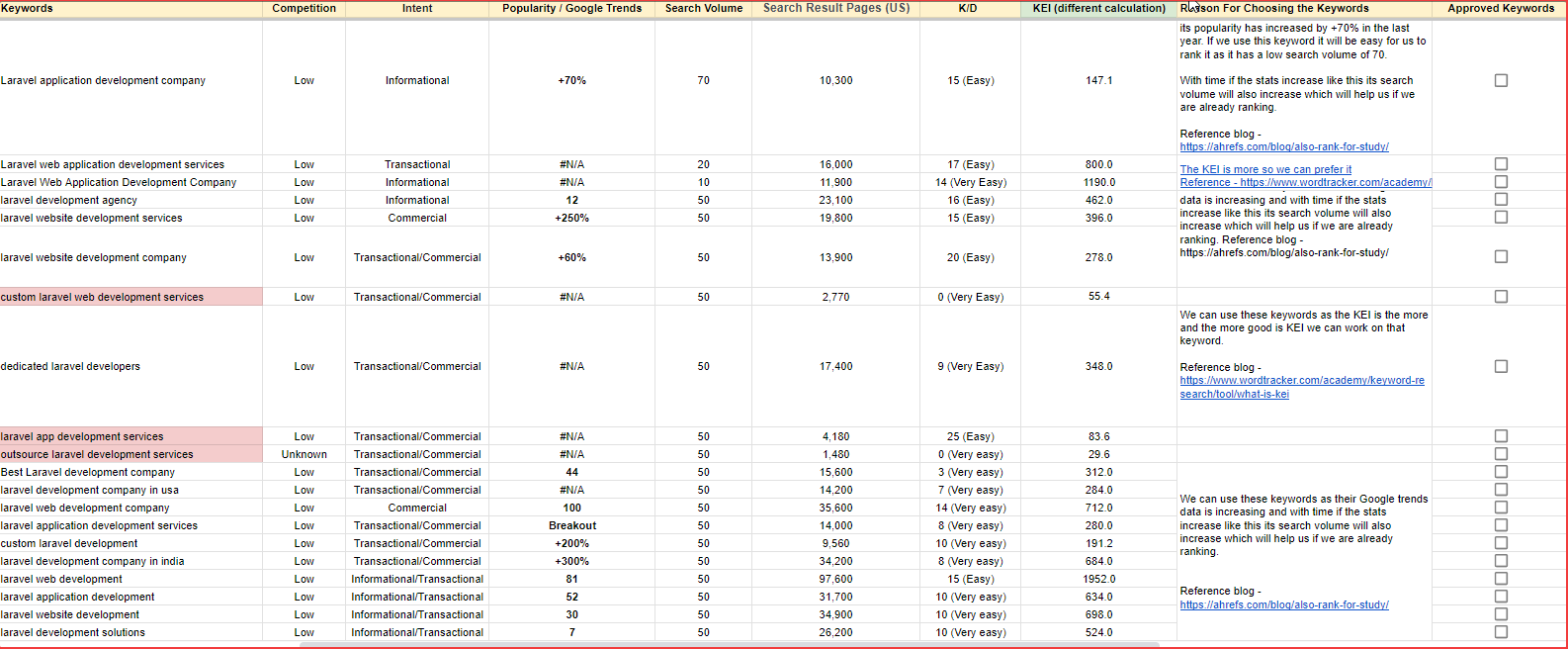
Primary Keywords
- Laravel Development Company
- Laravel development services (Using)
- Laravel web development services
- Laravel development (Using)
Secondary Keywords
- Laravel application development company
- Laravel web application development services
- Laravel Web Application Development Company
- laravel website development services
- laravel website development company
- dedicated laravel developers
- Best Laravel development company
- laravel development company in usa
- laravel web development company
- laravel application development services
- custom laravel development
- laravel web development
- laravel application development
- laravel website development
- laravel development solutions
Keyword Placement on the page
- We need to ensure that the chosen keywords are placed on our page and make sense.
2. Title Tag Optimization -
We have to ensure each page has a unique title tag after seeing what our top competitors are writing after verifying from Google.
- Some Important Points:
- Length: The meta title length should be between 50 to 70 characters.
- Primary Keyword: Include the primary keyword towards the beginning of the title.
Laravel Page Title -
Current Meta Title -
- Laravel Web Development Services Company/Agency
- Suggested Meta Title -
- Laravel Development Company | Official Laravel Partner - Webreinvent
3. Meta Description Optimization -
We have written meta descriptions that contain words that attract users to click and visit our website.
- Some Important Points:
- Length: Meta Descriptions can be 300 characters or longer, including the hidden parts, the ideal length should depend on our main goal, to provide value and encourage clicks.
- Primary Keyword: Include the primary keyword and make it compelling.
Laravel Page Description -
Current Meta Description
- Best Laravel web design company in India. WebReinvent is one of the leading Laravel development companies in Delhi India.
- Suggested Meta Description
- Webreinvent is the leading Laravel app development company and an official Laravel partner. Hire expert Laravel developers to enhance your website today!
4. Header Tags (H1, H2, H3, etc.)
The H1 tag should be the first headline that a user sees when the content loads. It indicates what your page is about and encourages visitors to continue reading your content.
- Some Important Points:
- H1 Tag: Use only one H1 tag per page, and include the primary keyword.
- Subheadings (H2, H3, etc.): Use subheadings to organize content and include secondary keywords.
Laravel Page H1 -
Current H1
- Official Laravel Partner Development Agency
- Suggested H1
- Most Trusted Laravel Development Company
5. Content Optimization
With content optimization, we can easily make the users (target audience) and search engines (like Google and Bing) understand our content. So it is an important ranking factor.
Some Important Points:
- Quality Content: Ensure content is not plagiarised and makes sense.
- Keyword Density: Maintain a natural keyword density; avoid keyword stuffing.
- LSI Keywords: Use Latent Semantic Indexing (LSI) keywords that we have added as secondary keywords to add context.
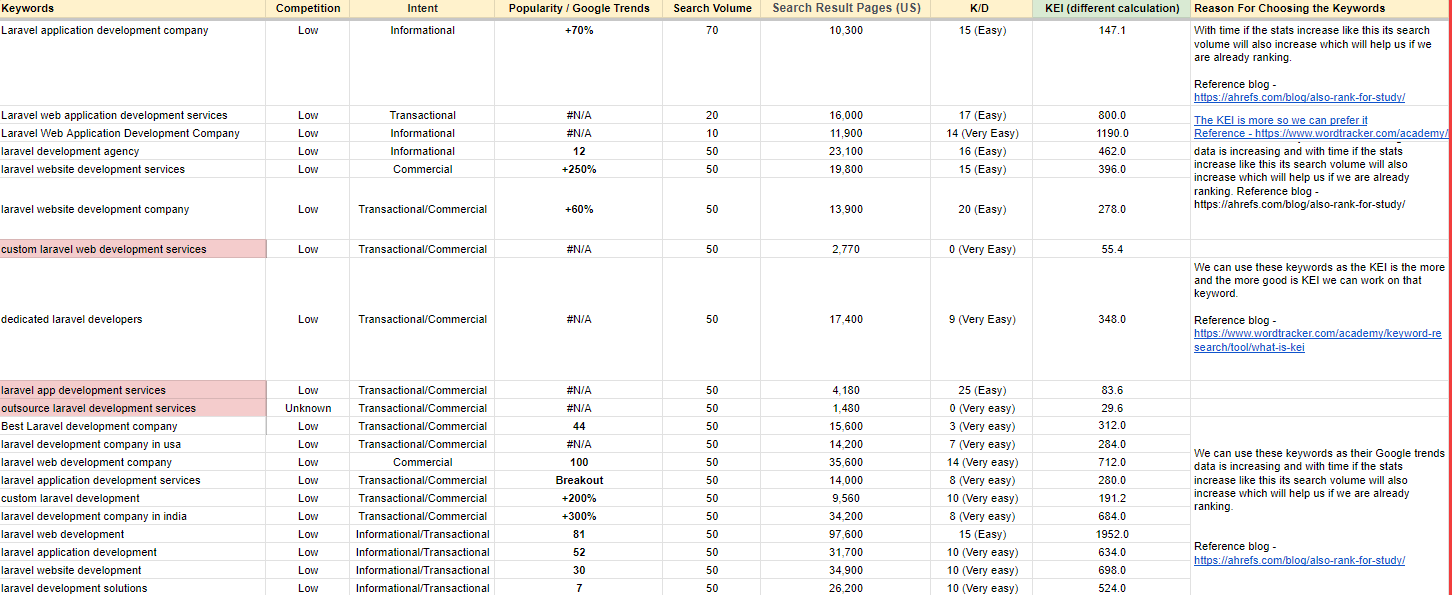
6. Internal Linking
Website page with the most amount of internal linking ranks much higher than pages with fewer internal links.
- Some Important Points:
- Relevance: Link to relevant internal pages to improve navigation and SEO.
- Anchor Text: Use descriptive anchor text that includes keywords.
7. Image Optimization
As Google doesn't read images so if we describe them with image alt text it helps search engine bots like Google and Bing understand image content.
- Some Important Points:
- Alt Text: Use descriptive, keyword-rich alt text for images.
- File Names: Use descriptive file names with keywords.
- Compression: Compress images to improve load times without sacrificing quality.
8. Schema Markup
Schema markup is a type of code added to web pages to help search engines understand and display content more effectively. It uses structured data to describe various types of content (like products, articles, events) and their relationships, which can lead to richer search results and better user engagement.
Preferred Schema -
- Breadcrumbs
Breadcrumbs in SEO are a navigational aid showing the path from the homepage to the current page, displayed as clickable links (e.g., Home > Category > Subcategory > Product). They enhance user navigation, provide context to search engines about site structure, and improve overall SEO by facilitating easier crawling and understanding of site hierarchy.
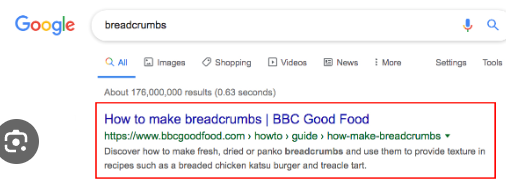
Implementing the Breadcrumbs schema in SEO improves user navigation by clearly showing the path within a website's hierarchy. It reduces bounce rates, enhances site usability, helps search engines understand site structure, and potentially improves sitelinks in search results, boosting overall visibility and click-through rates.
- Rating & Reviews
The Rating & Reviews schema from Schema.org provides a standardized way to represent ratings and reviews on websites.
Implementing the Rating & Reviews schema enhances SEO by improving search visibility with rich snippets, boosting rankings, increasing click-through rates, and building user trust.
- FAQPage (already embedded)
The FAQ schema is a structured data markup defined by Schema.org that helps search engines display Frequently Asked Questions (FAQs) directly in search results. It consists of questions and corresponding answers, making content more visible and user-friendly. Implementing this schema can enhance search visibility with rich snippets, improve user experience by providing quick answers, increase click-through rates, and optimize content for voice search.
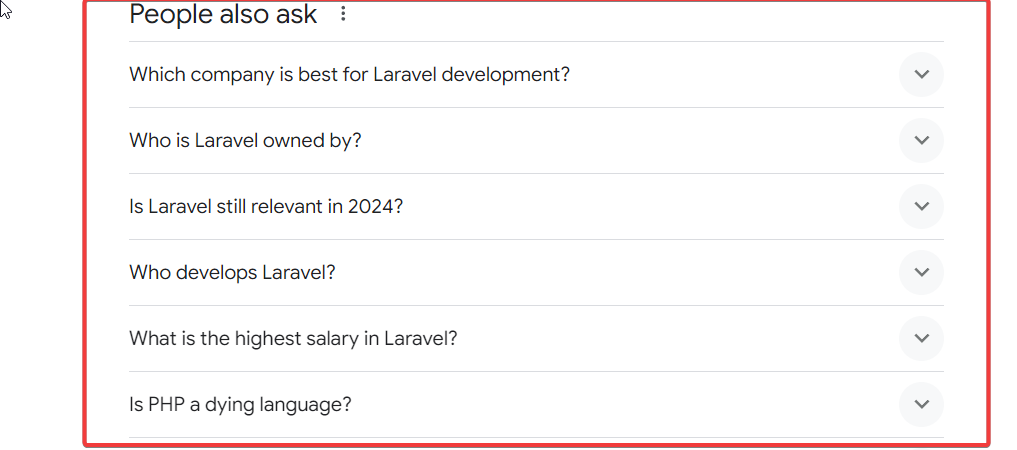
The FAQ schema boosts SEO by enhancing search visibility with rich snippets, providing quick answers, improving user experience, increasing click-through rates, and optimizing content for voice search.
- Sitelinks search box
The Sitelinks Search Box in SEO is a feature in Google search results that lets users search directly within a website from the SERP. It appears as a search box next to the site's name, offering quick access to specific content and enhancing user convenience. Websites enable this feature by implementing structured data markup (Schema.org's SearchAction schema) and meeting Google's eligibility criteria.

The Sitelinks Search Box in SEO allows users to search within a website directly from Google's search results page, improving user experience, increasing site visibility, and potentially boosting click-through rates. It requires structured data markup for implementation, enhancing search engine understanding of site content and structure.
9. Rich Snippets
Rich Snippets in SEO are enhanced search results that display additional information such as ratings, prices, and dates directly in search engine listings. They are generated using structured data markup on web pages, improving user understanding and potentially increasing click-through rates.
Different Types of Rich Snippet
- Product Rich Snippets
Product rich snippets are useful if you have an e-commerce website. They provide more information to your potential customers about your products—like whether the product is currently in stock, its shipping information, and its price.

- Recipe Rich Snippets
Recipe rich snippets give more information about the recipe on the page, such as how long it takes to prepare, its ingredients, and reviews.
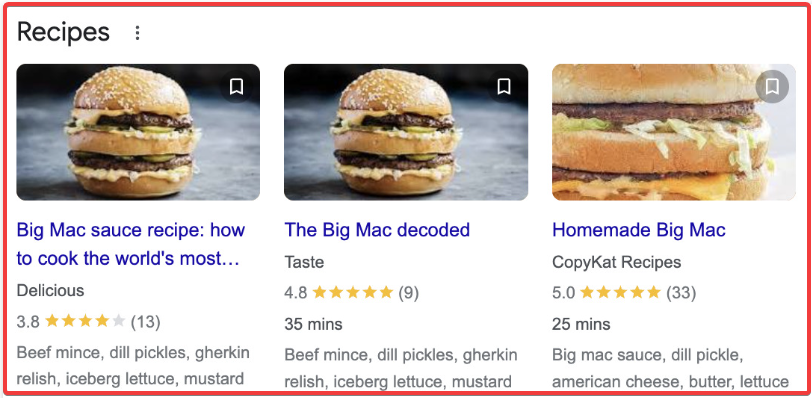
- Event Rich Snippets
Event snippets highlight the date and location of your events. They’re useful if you have ticketed events like concerts or shows.
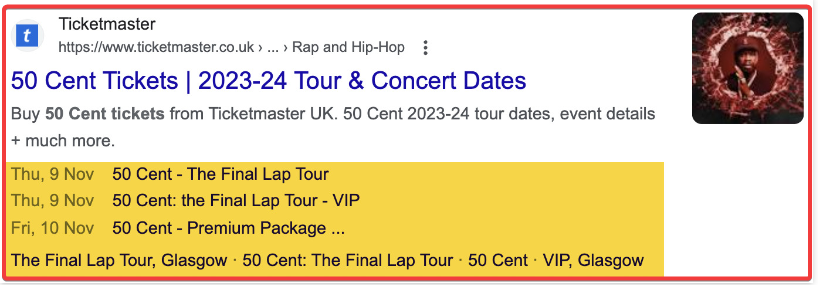
- Article Rich Snippets
To mark up your content, you need to use a structured data type called “Articles.” With its help you can easily add additional details such as headline, URL, short description, images, and publish date to your search results.

- Local business Rich Snippets
With local business markup, you'll have an opportunity to present your company in the most fascinating way. Google demonstrates reviews, details about working hours and different departments within a business. This snippet will help your website appear in the most relevant local search results.
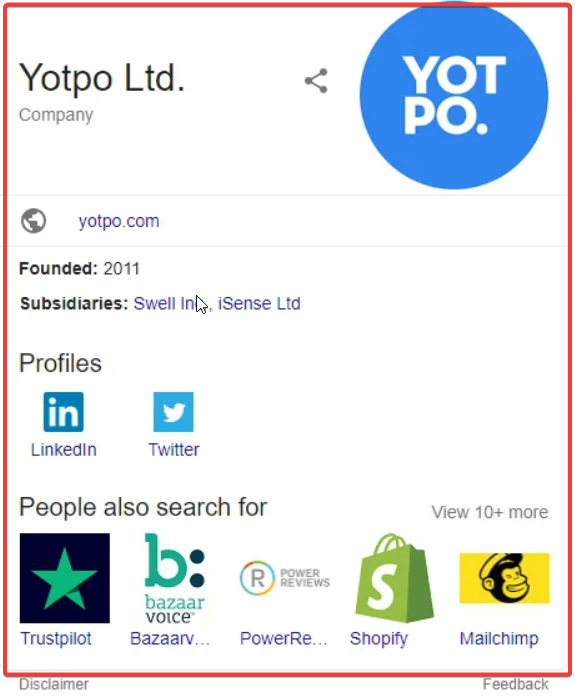
- Organization Rich Snippets
Organization schema markup is a code that you can put on your website to provide search engines with detailed information about your organization. This can include details like the organization's name, address, phone number, and logo.
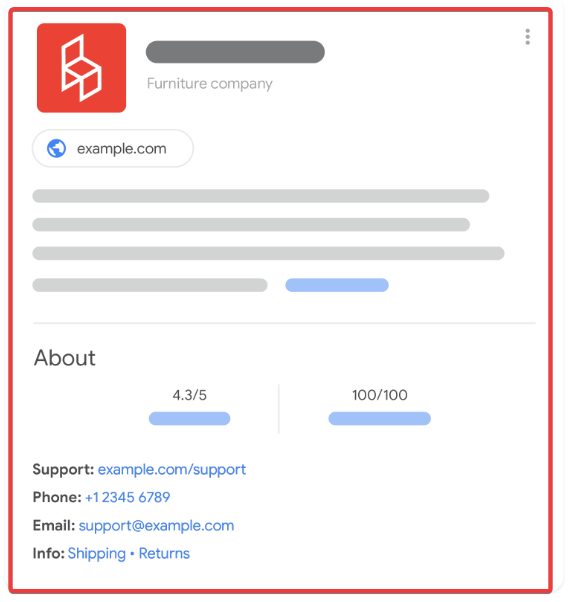
- Video Rich Snippet
A video rich snippet is a special kind of snippet, which makes video appear in search results by means of structured markup.
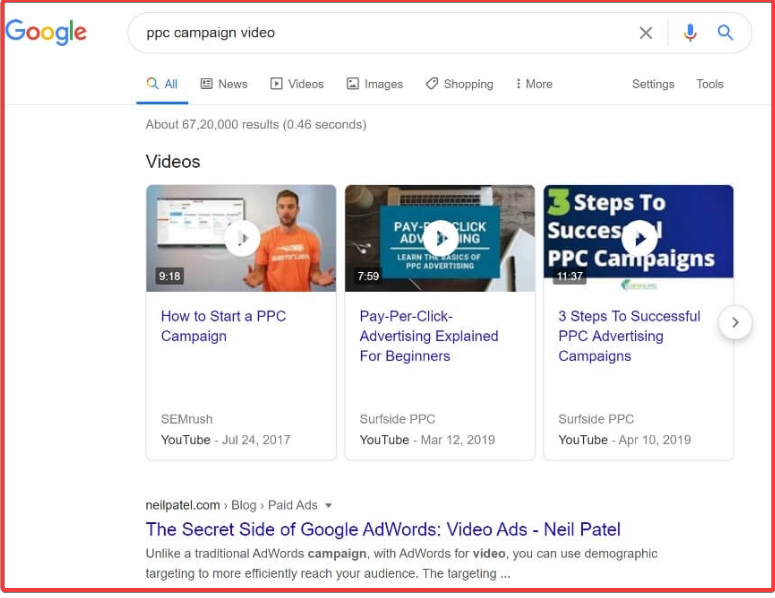
To Know More About Snippets Explore Google Structure Data Doc
10. Canonical Tags
A canonical tag, also known as a canonical link or "rel canonical," is a tag in the source code of a page that indicates to search engines that a master copy of the page exists. Canonical tags are used in SEO to help search engines index the correct URL and avoid duplicate content.
- Use canonical tags to prevent duplicate content issues.
What Are URL Parameters?
URL parameters (also known as query strings or URL query parameters) are elements inserted in your URLs to help you filter and organize content. Or implement tracking on your website.
To identify a URL parameter, look at the portion of the URL that comes after a question mark (?).
URL parameters include a key and a value that are separated by an equals sign (=). Multiple parameters are then separated by an ampersand (&).
A complete URL string with parameters looks like this:

And here’s what each part means:
- Key1: First variable name
- Key2: Second variable name
- Value1: First property value
- Value2: Second property value
- ?: Query string begins
- =: Value separator
- &: Parameter separator
URL Query String Examples
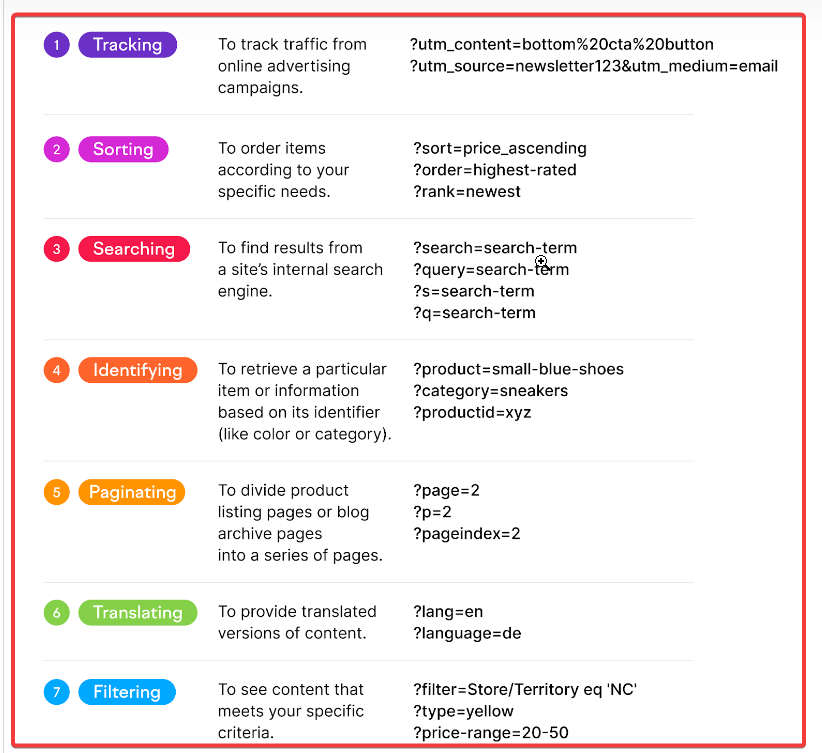
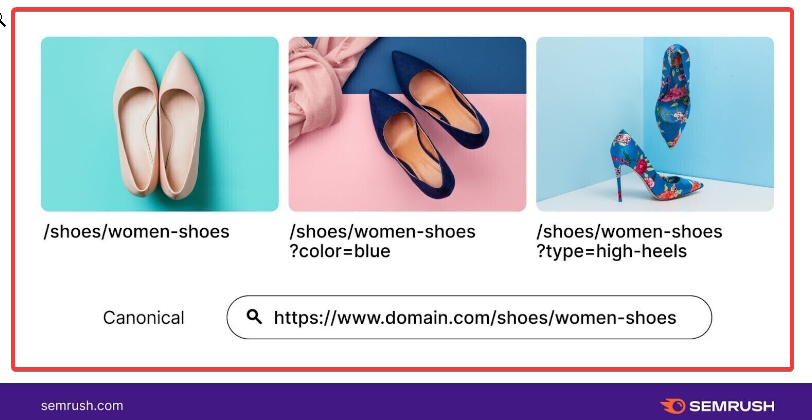
Parameterized URLs make it easier to modify content or implement tracking on your site, so it’s worth using them when you need to.
You’ll need to let web crawlers know whether to crawl URLs with parameters. And highlight the version of the page that’s the most valuable.
Take your time and decide which of your URLs shouldn’t be indexed. With time, web crawlers will better understand how to navigate and treat your site’s pages.
To know more visit Semrush URL Parameters Guide
Navigating SGE and GEO: Optimize Your Web Presence Effectively
What is Google's Search Generative Experience (SGE)
As announced on May 14th, Google began rolling out AI Overviews to US-based searchers first, shortly followed by other countries.
Originally introduced as a part of the Google Search Labs experiment, Search Generative Experience (SGE), that users had to opt into, it will be available to over a billion searchers by the end of 2024.
How Do Google AI Overview Work?
Query Processing
When you type in a query, the AI processes your words and generates a text response, similar to how ChatGPT functions.
Document Selection
Google’s algorithm then selects a small group of relevant web pages that contain information related to the generated response.
- Here is a GIF of how AI Overviews look in Google Search

You won’t see AI Overviews for all your searches. AI Overviews are reserved to answer more complex questions where Google feels it can add value beyond the search results. If AI Overview doesn’t add value to what Google Search shows by default, Google will not show an AI Overview.
Key SGE Statistics
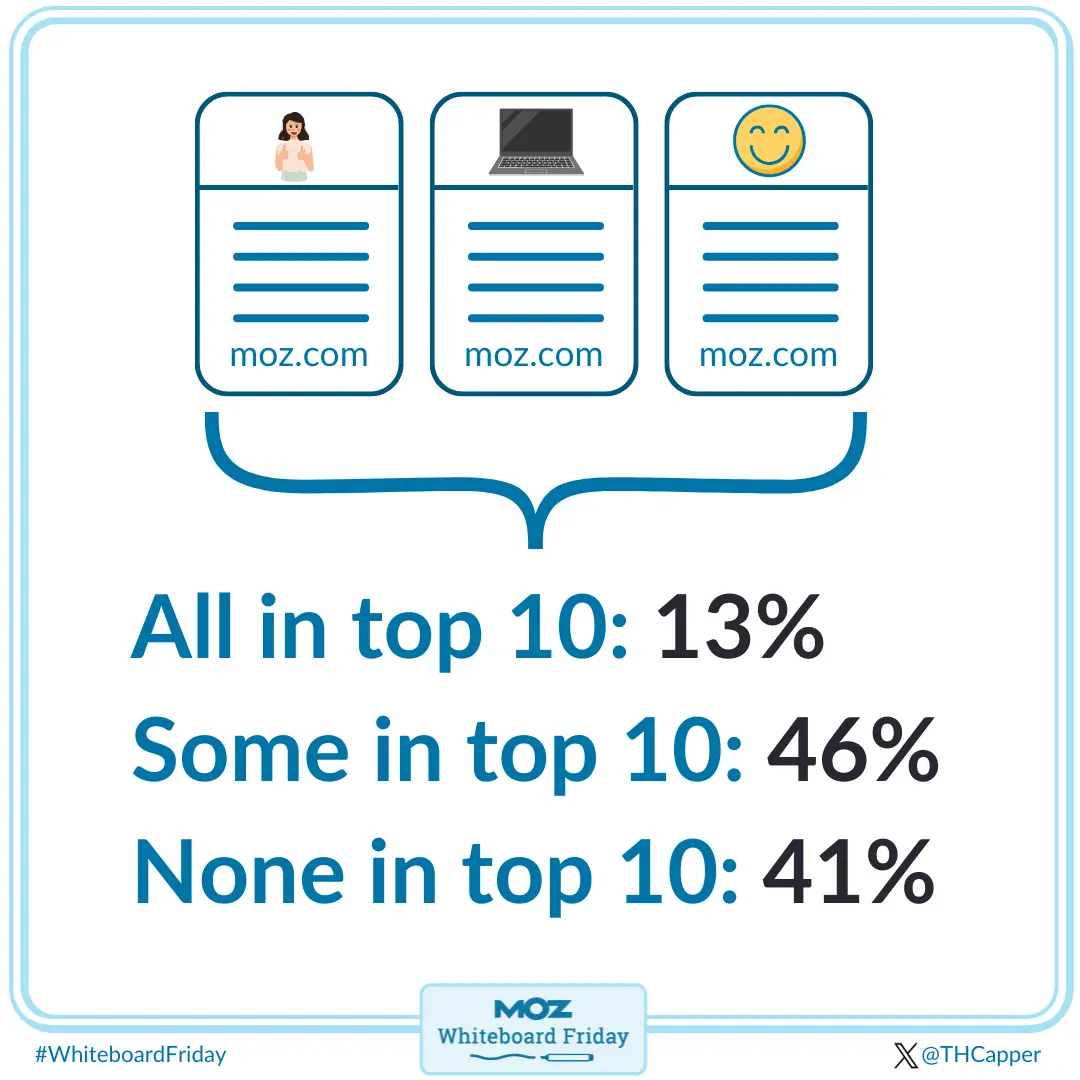
Top keywords from various categories in a small study, focusing on 100 search results pages (SERPs) in the US on desktop. We found that:
- In only 13% of these search results, the top three links in the new search experience (SGE) were the same as the top organic (regular) results. This means there was a complete overlap.
- In 41% of the cases, none of the top three links from SGE appeared in the organic results.
This shows that the new search system (SGE) isn't just a rehash of the regular organic results; it's quite different.
To read more on it visit moz blog on Stats About SGE
7 most effective tactics for how to rank in SGE
- Get into Google Knowledge Graph
- Target qualified long-tail searches
- Improve content readability
- Build supporting visuals
- Leverage structured data
- Use Google Merchant Center
- Enhance E-E-A-T signals
Learn More with How to Rank in SGE by webfx and How to prepare for Google SGE by searchengineland
What is Generative Engine Optimization (GEO)
- Definition: The adaptation of content optimization strategies to align with the capabilities and expectations of AI-driven search engines. GEO combines traditional SEO techniques with an understanding of how generative AI models process and prioritize content.
- Era: Represents a more recent phase, acknowledging the significant role of AI in shaping search experiences and the necessity for content to be optimized for these AI-driven environments.
- Objective: To ensure content is discovered, accurately interpreted and favorably ranked by AI-enhanced search engines.
Here is a GIF of how AI Overviews look in Google Search
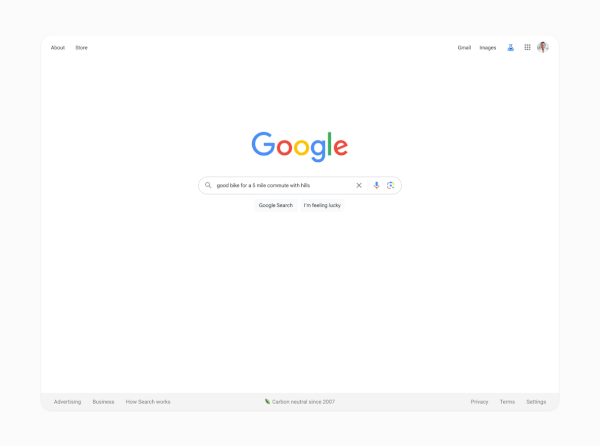
It might be helpful to further drill down on the differences between Search Engine Optimization, Search Generative Experience and Generative Engine Optimization:
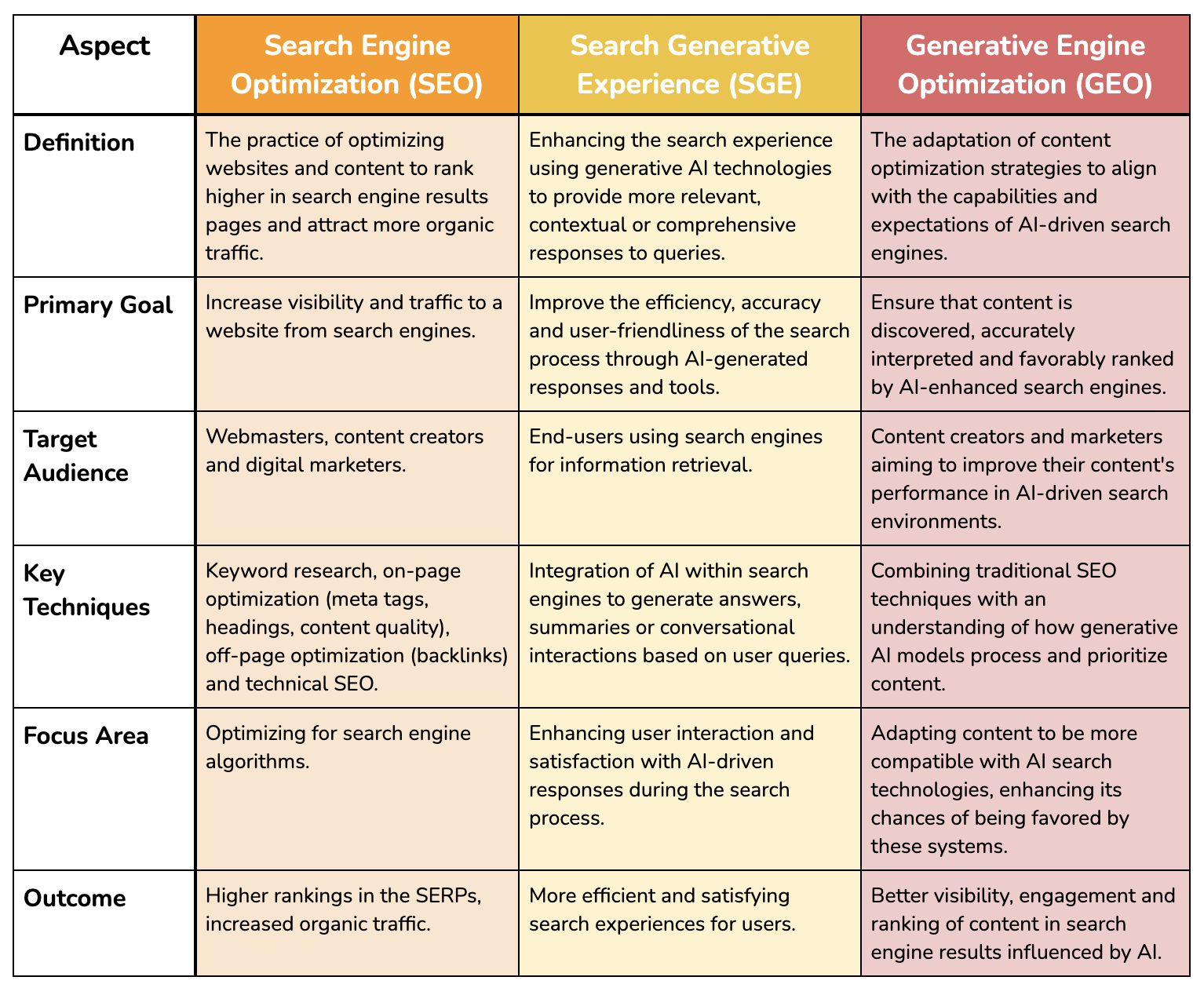
In a nutshell, you could say that:
From SEO to SGE: This transition reflects a shift from purely algorithmic search optimization towards enhancing the search experience with AI, focusing on user interaction and satisfaction.
From SGE to GEO: This step acknowledges the pervasive influence of AI on search technologies, necessitating a new approach to content optimization that goes beyond traditional SEO to include AI-specific considerations.
How to Optimize for GEO:
To successfully implement GEO, leverage generative AI to create content that appeals to both humans and machines. Here are some strategies:
- Research Customer-Relevant Topics:
Use keyword tools to find what interests your audience and what questions they're asking. Validate these queries on Google and assess their relevance to AI interactions. - Create or Optimize Tailored Content:
Develop high-quality, engaging content addressing these topics. Use reputable sources and authoritative language to show trust and expertise. - Incorporate Structured Data:
Use schema markup to provide context and structure, making your content easier for AI to understand and index. - Focus on User Intent:
Tailor your content to fulfill the user's search intent, helping you stay ahead of evolving algorithms. - Embrace Multimedia:
Diversify your content with videos, infographics, and quizzes to engage both human readers and AI-driven search engines.
Learn more about (GEO) with Generative Engine Optimization (GEO) by singlegrain and What's (GEO) & How To Do It by foundationinc.co
What is E-E-A-T
E-E-A-T stands for Experience, Expertise, Authoritativeness, and Trustworthiness. It's a set of criteria used by Google to evaluate the quality and reliability of web content. Websites that demonstrate strong E-E-A-T are more likely to rank well in search engine results because they are considered trustworthy sources of information.
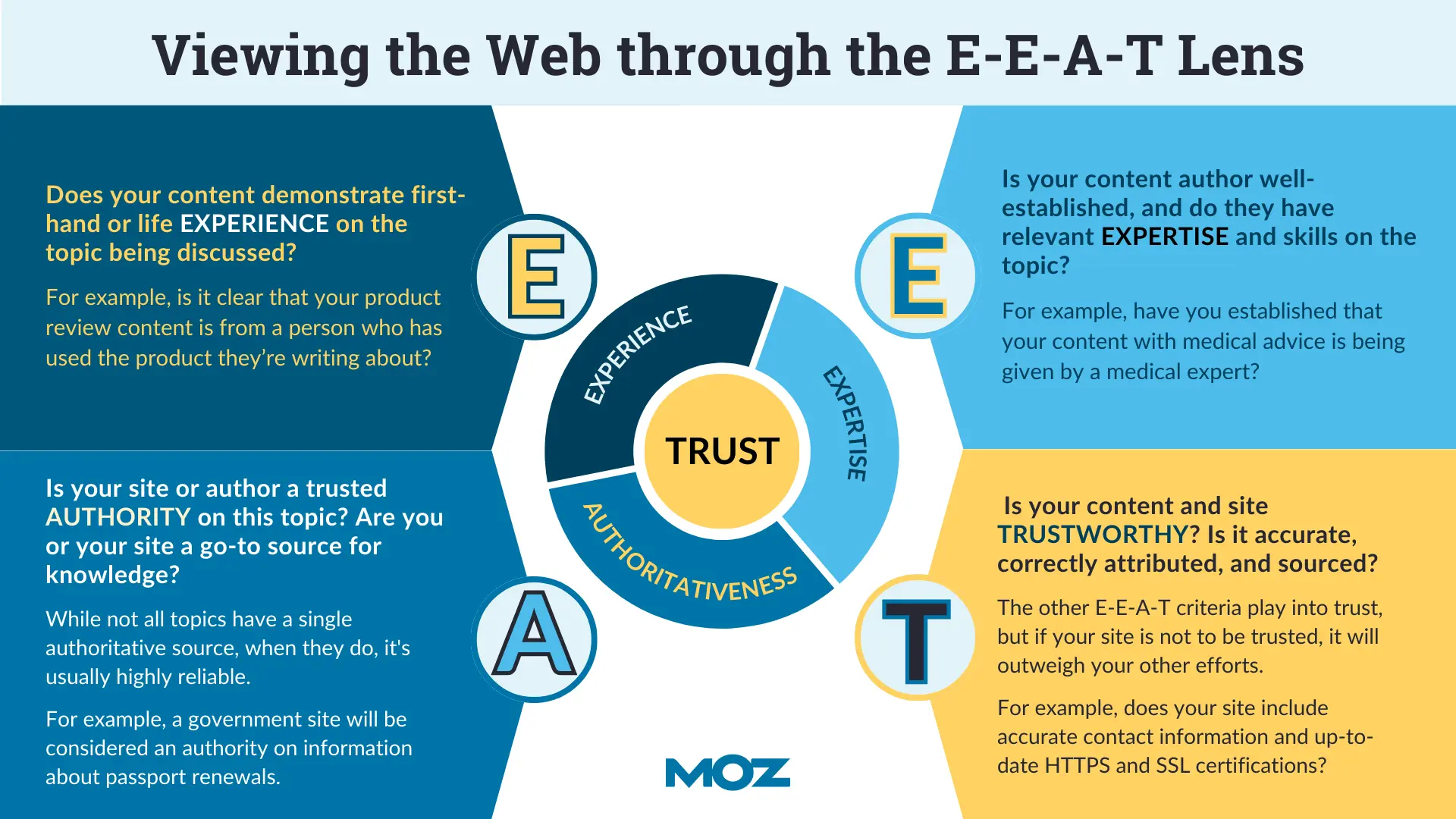
How to Improve Your Site’s E-E-A-T
1. Create High-Quality Content
Your site should provide people-first content. This means content that answers questions, provides advice, and leaves the reader feeling satisfied.
We should ensure that the content we write is:
- Original
- Helpful to users
- Written by people, for people
2. Provide Author Info and Transparency
Google wants to know that the person writing a piece of content is a legitimate source of information.
Be sure to create an About Us page to introduce your team (if applicable). And individual author pages to highlight specific writers.
Author bios help establish transparency and E-E-A-T by showing author credentials and past work
3. Create a Positive Brand Reputation
Your brand’s reputation can impact the trustworthiness of your content and site overall. So online reputation management is crucial for Google E-E-A-T SEO.
This means you should keep an eye out for negative reviews or press. If something does come up, respond promptly and professionally.
To know more about EEAT you can read Moz EEAT Guide
What are YMYL Pages?
YMYL “Your Money or Your Life” pages cover or touch on topics that can potentially impact a person’s future happiness, health, financial stability, or safety.
For example, a page that explains how to maximize your 401k for retirement is a YMYL page. Another example of a YMYL page is one on how to diagnose and treat diabetes.
Benefits of Using YMYL Pages
- Enhanced Trust and Credibility
Authority and Expertise: Accurate, expert-backed information builds trust.
Trustworthiness: Reliable content fosters long-term user relationships. - Improved User Experience
Relevance and Accuracy: Users receive precise, useful information.
Safety and Security: Secure handling of sensitive data ensures user safety.
How to Write YMYL Related Content
Since the stakes with YMYL niches are so high, it’s important that the content is always built upon solid evidence. Always back up any claims you make with citations from trustworthy external sources. Make sure you link to these reputable sites within your page. Otherwise, Google’s engine won’t know you’re citing all these studies, data, or professional journal entries.
You can also read more about Content Tips for YMYL with contentwriters guide.
What is AI Chat Bot
An AI chatbot is a computer program designed to simulate conversation with human users, especially over the internet. It uses artificial intelligence techniques such as natural language processing (NLP), machine learning, and sometimes even deep learning to understand and respond to user queries or prompts in a human-like manner.
Benifits of Using AI Chat Bot
- 24/7 Availability: They provide instant responses round the clock, improving customer service availability.
- Effective: Automating tasks reduces operational costs compared to human agents.
- Scalability: Capable of handling multiple conversations simultaneously, making them adaptable to varying demand.
- Improved Efficiency: Streamlines processes, reduces response times, and automates repetitive tasks.
- Enhanced Customer Experience: Offers consistent and personalized interactions, leading to higher customer satisfaction.
Latest AI Updates by Google
Google is working on its new AI model that is Labs. Google which is still under development and soon when all its features are launched we can use it to reduce much of our on-page work.
Some of the Interesting Tools that it has already launched are:
1. Gemini for Google Workspace
Gemini is the AI-powered assistant from Google, built right into Gmail, Docs, Sheets, and more, with enterprise-grade security and privacy.
Google is also offering a 14 days Free Trial For this
2. Aitestkitchen by Google
Experiment with the intersection of AI and creativity that includes VideoFX, ImageFX, MusicFX, and TextFX.
- VideoFX: Google uses AI to enhance video editing with features like automated edits, stabilization, and smart transitions.
- ImageFX: Google's AI enhances image editing with automatic adjustments, object removal, and creative filters based on content analysis.
- MusicFX: AI-driven tools for noise reduction, audio enhancement, and music composition cater to musicians of all levels.
- TextFX: Google's AI improves text editing with grammar suggestions, summarization, translation, and sentiment analysis, boosting productivity in content creation.
Tool to Prefer for On-Page SEO
SEMrush AI stands out as a superior SEO tool for several reasons:
- Data Integration
SEMrush integrates all available PPC, display, and organic data, providing a holistic view of your SEO landscape [Reference Blog].
- Time-Saving Automation
SEMrush AI can speed up time-consuming SEO tasks, such as generating content ideas, outlines, and schema for websites [Reference blog].
- Versatile SEO capabilities
SEMrush offers a wide range of features, including keyword research, local listing audits, competitor analyses, social media management, and keyword ranking tracking [Reference Blog].
- AI-powered insights
The tool provides data-driven strategies and optimizes content, giving you a competitive edge in SEO [Reference Blog].
By leveraging these features, SEMrush AI empowers users to create more effective SEO strategies and achieve better search engine rankings.
On-Page SEO Checklist
For all my checklists, I've included necessary details, references for further assistance, and attached links for easy access.
- Meta Title
- Length: The meta title length should be between 50 to 70 characters.
- Primary Keyword: Include the primary keyword towards the beginning of the title.
- Meta Description
- Length: Meta Descriptions can be 300 characters or longer, that provide value and encourage clicks.
- H1 Tag
- Length: Maximum length for H1 (60 characters)
- Header Tags (H1, H2, H3, etc.)
- H1 Tag: Use only one H1 tag per page, and include the primary keyword.
- Subheadings (H2, H3, etc.): Use subheadings to organize content and include secondary keywords.
- Content Optimization
- Keyword Density should be 2% in a Page
- Use up to 10 LSI keywords in your web copy
- Internal Linking
- Relevance: Link to relevant internal pages to improve navigation and SEO.
- Anchor Text: Use descriptive anchor text that includes keywords.
- Image Optimization
- Alt Text: Use descriptive, keyword-rich alt text for images.
- File Names: Use descriptive file names with keywords.
- Compression: Compress images to improve load times without sacrificing quality.
Example
<img src=“girl-driving-car.png” alt=“Girl driving a car on an empty highway in the day.”/>
- Canonical Tags
- Use canonical tags to prevent duplicate content issues.
Format for Canonical Tag
<link rel=“canonical” href=“https://example.com/sample-page/” />
- Schema Markup
Schema markup enhances search engine understanding, helping search engines better interpret and rank your web pages.
Conclusion
If we follow this approach it ensures a comprehensive approach to on-page SEO, covering all critical aspects to enhance search engine rankings and user experience.
On Page SEO - Vue.JS
On Page SEO Checklist
Here's a structured layout for an on-page SEO checklist. This layout covers the essential aspects of on-page SEO and provides a comprehensive checklist for optimizing web pages.
1. Keyword Research and Optimization
- Primary Keyword Selection: Ensure the primary keyword is relevant to the content and has sufficient search volume.
Primary Keywords - vuejs development services, vuejs development company, hire vue js developer - Secondary Keyword Selection: Identify and incorporate secondary keywords to support the primary keyword.
Secondary keywords - top vue js development agency, outsource vuejs development services, hire vue js experts
Reference Image
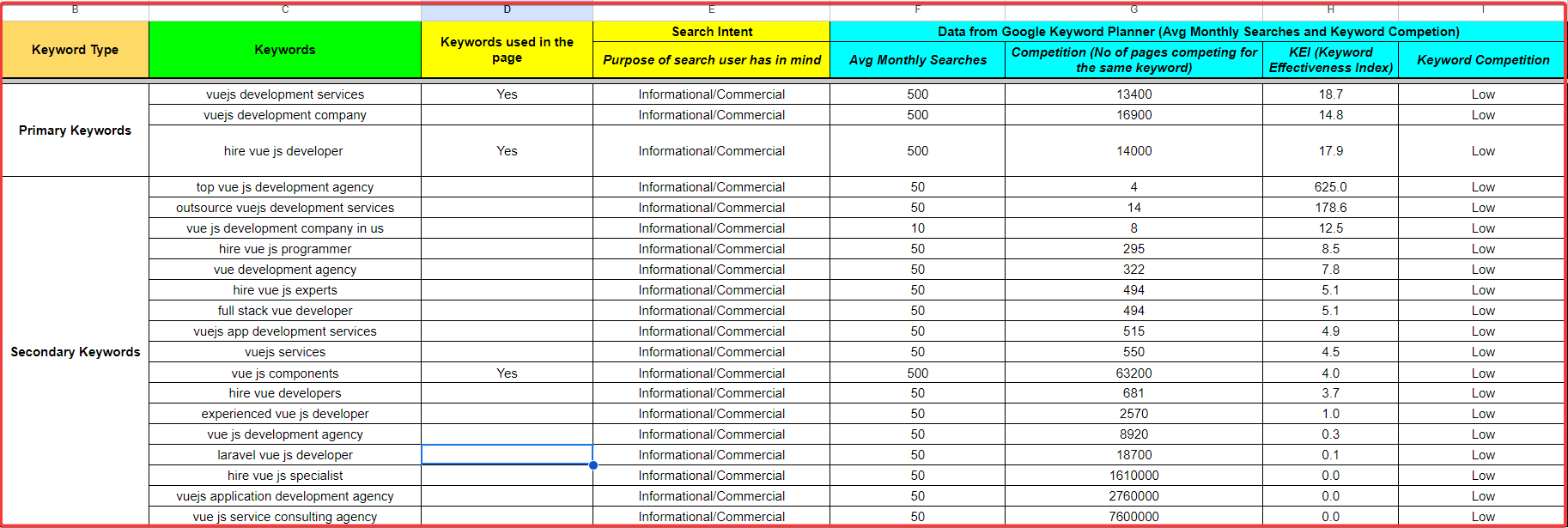
2. URL Structure
Know more about SEO Friendly URL Structure
- SEO-Friendly URLs: Keep URLs short, descriptive, and include the primary keyword.
- Current URL: https://webreinvent.com/technologies/frameworks/vuejs-development-services
- Suggested URL: https://webreinvent.com/technologies/vuejs-development-services
Reason - When we remove vuejs development services from URL https://webreinvent.com/technologies/frameworks then this URL is showing 404 so the hierarchical structure of the URL (domain > technologies > frameworks > vuejs-development-services) is not logical as frameworks folder is not working and will affect navigation of the website or we can make a page of frameworks by that the URL structure will not get affected.
3. Title Tag Optimization
- Current Title Tag: Vue.js Application Development Services Company In India
- Suggested Title Tag: Vue.JS Development Company | Hire Expert Vue JS Developer - WebReinvent
Reason - Including "Vue.JS Development Company" and "Hire Expert Vue.js Developer" targets specific search terms potential clients might use, improving SEO. It clearly communicates the services offered (development and hiring experts) and the company's name, making it more attractive and informative.
4. Meta Description Optimization
Know more about Meta Description
- Current Meta Description: WebReinvent provide Vue.js Custom Development and Maintenance services to leading Business Domains. Our expert Vue.js developers follow the Agile methodology and provide cost effective Vue.js development solutions.
- Suggested Meta Description: Webreinvent provides vue.js development and maintenance services. Get vue.js solutions from our experts at affordable prices and get the best services from leading vue.js development company - WebReinvent
Reason - The suggested description is shorter and easier to read, making it more appealing to potential clients. Phrases like "Get vue.js solutions" encourage immediate action, which can lead to higher engagement. Mentioning "leading vue.js development company" and "experts" reinforces the company's credibility and specialization. These elements make the description more engaging and persuasive, likely improving click-through and conversion rates.
5. Header Tags
- Current H1 Heading Tag: Official Vue.js Partner Development Agency
- Suggested H1 Heading Tag: Vue.js Development Services
Reason - This is a Primary keyword and has a high search volume. Which will help search engine and users to understand the topic better.
Note - There should be only one H1 tag per page.
- H2, H3 Heading Tags: Use subheadings to organize content and include secondary keywords. Mark them as H2 and H3.
6. Canonical Tag
- Current Canonical Tag: Missing
- Suggested Canonical Tag: Same as URL
Reason - It helps search engines understand which version of a page is the preferred one, avoiding confusion from similar or duplicate content. All the ranking signals (such as backlinks) are consolidated to the canonical page, boosting its search engine ranking. It directs search engines to the primary page, ensuring more efficient crawling and indexing of the website's content.
7. Breadcrumb
- Current Breadcrumb: Missing
- Suggested Breadcrumb: Home / Technologies / Frameworks / Vue.JS Development Company (Based upon URL Structure)
Reason - Breadcrumbs help search engines understand the site's structure, leading to better indexing and potentially higher rankings. They improve user experience by providing clear navigation paths, helping users easily understand their location within the website. Easy navigation encourages users to explore more pages, reducing bounce rates and increasing engagement.
8. Robots Tag
- Current Robots Tag: Missing
- Suggested Robots Tag: Index, Follow
Reason - They allow us to specify pages search engines should index and which ones to ignore, preventing unnecessary or irrelevant content from appearing in search results.
9. Content Optimization
Know more about Content Optimization
- Content Quality: Ensure Content is High quality, relevant and provides value to users.
Read more - https://www.semrush.com/blog/quality-content
- Keyword Density: Maintain natural keyword density and avoid keyword stuffing (Keyword density 1-2%)
Read more - https://surferseo.com/blog/why-keyword-density-matters
- Content Length: Aim for comprehensive content (typically 1000+ words) depending on the topic and competition. Add engaging visual content as well.
10. Internal Linking
Know more about Importance on Internal Linking
- Relevance: Link to relevant internal pages to improve navigation. Get links to most important pages of the website Ex:- Home page, Categories, etc.
- Anchor Text: Use descriptive anchor text that includes keywords.
Reason - Internal links help users navigate through your website. They connect relevant pages, making it easier for visitors to find information. A well-structured internal linking system improves user experience by guiding users to related content they might be interested in. When one page links to another within the same domain, it passes some of its authority (PageRank) to the linked page. This helps search engines understand the hierarchy and importance of pages within your website. Pages with more internal links tend to rank better in search results. Anchor text used in internal links can provide additional context to search engines about the content of the linked page. Using relevant keywords in anchor text can help improve the ranking of the linked page for those keywords.
11. Image Optimization
Know more about Image Optimization
- Alt Text: Use descriptive, keyword-rich alt text for all images used.
- Image File Name: Use descriptive file names with keywords
Ex:- /images/keyword/_as/_file/_name.jpg - Compressed Images: Optimized images reduce the file size without sacrificing quality, which helps in faster loading times. Faster loading pages are favored by search engines and improve user experience, which can indirectly impact rankings.
Reason - Image optimization not only improves the performance and user experience of your website but also contributes to SEO by enhancing page load speed, attracting traffic from image search, providing descriptive information for search engines, and increasing user engagement. Therefore, it's essential to include image optimization as part of our overall SEO strategy.
12. Rich Snippets (Schema Markups)
Know more about Schema Markups
Schemas, particularly in the context of web development, refer to structured data formats that help search engines understand the content on your website. By using schemas, we can enhance our site's visibility and improve search engine optimization (SEO)
- FAQ Schema: Already Added
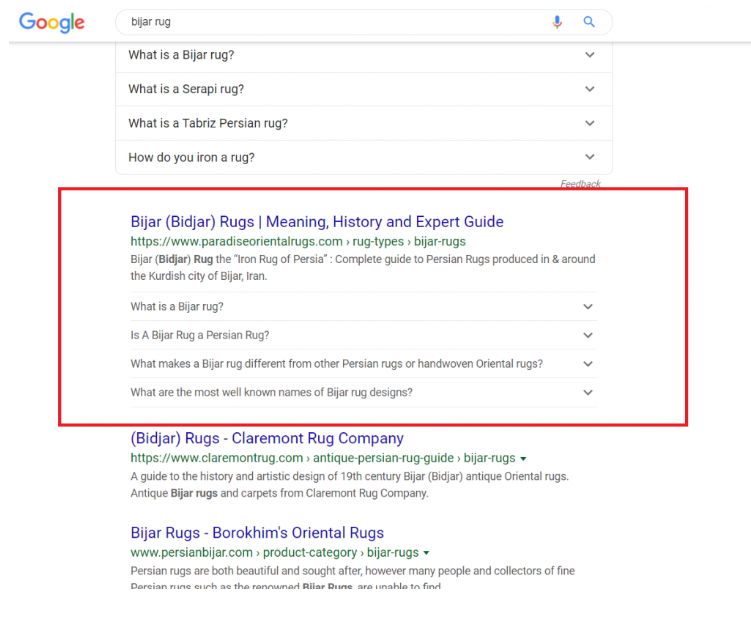
- Breadcrumb Schema, Review Schema: We need to implement these schema on our Vue.JS page.
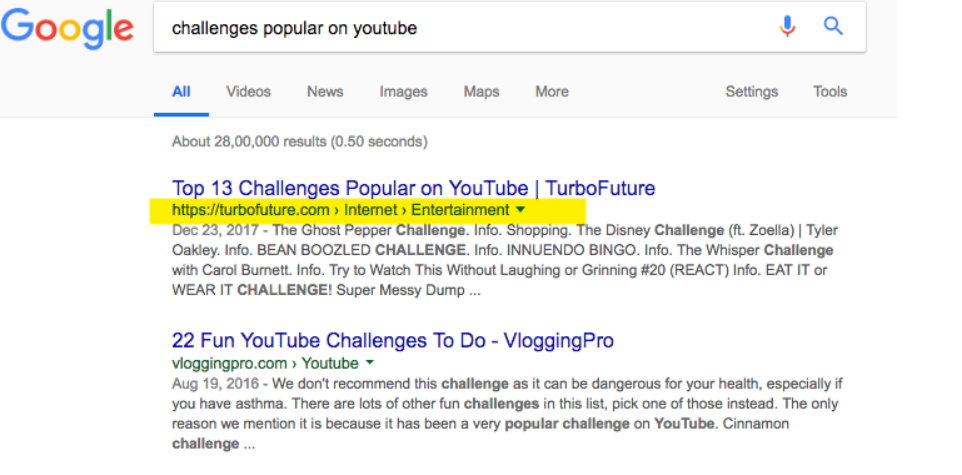
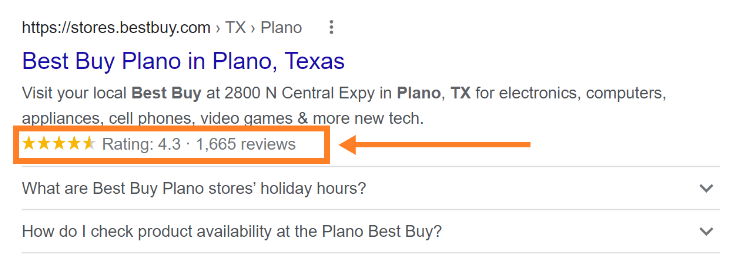
Reason - By adding rich snippets on the page will improve Search Visibility. Improve click through rate (CTR) and will enhance user experience.
- Other Schema Markups:
1.Article Schema
- Usage: For news articles, blog posts, and similar content.
- Attributes: headline, author, datePublished, image, etc.
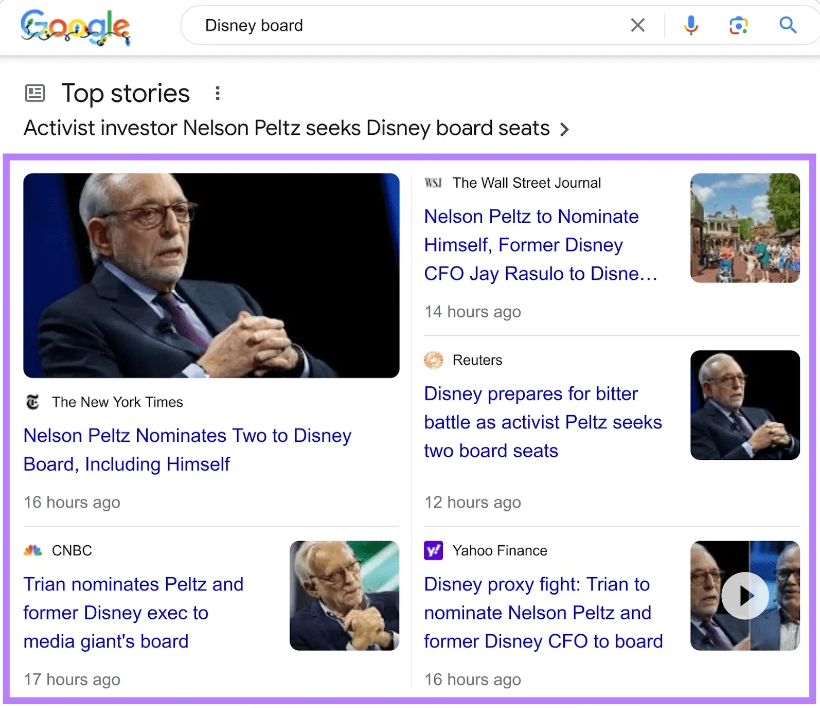
2. Local Business Schema
- Usage: For local businesses to improve visibility in local search results.
- Attributes: name, address, telephone, openingHours, geo, etc.
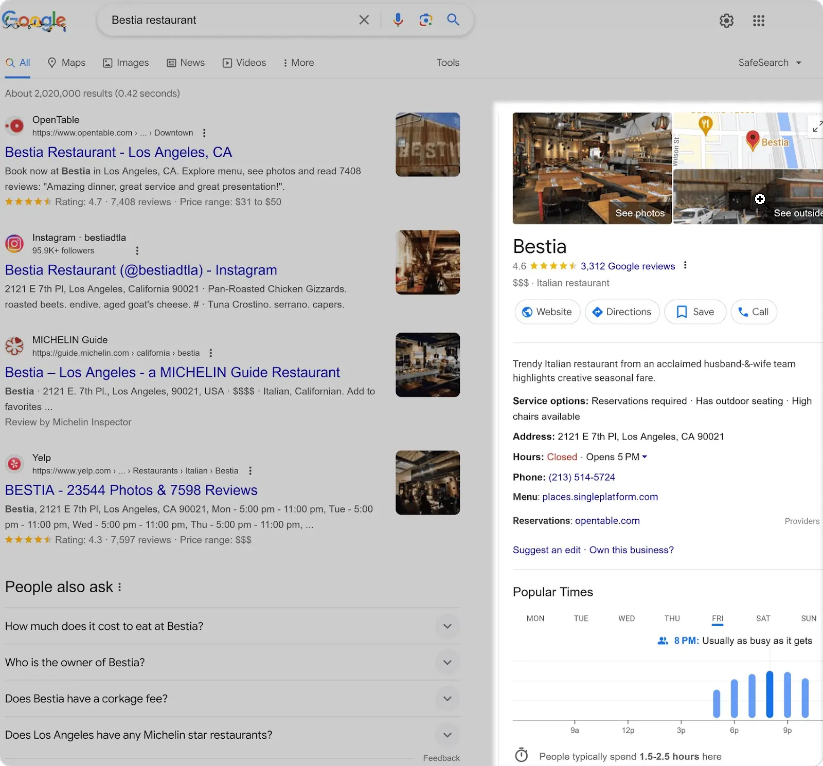
3. Product Schema
- Usage: For e-commerce websites to describe products.
- Attributes: name, image, description, sku, offers (with price and availability), etc.

4. Review Schema
- Usage: For user reviews and ratings of products, services, or businesses.
- Attributes: itemReviewed, reviewRating, author, datePublished, etc.

5. Recipe Schema
- Usage: For websites with cooking recipes.
- Attributes: name, ingredients, instructions, cookTime, nutrition, etc.
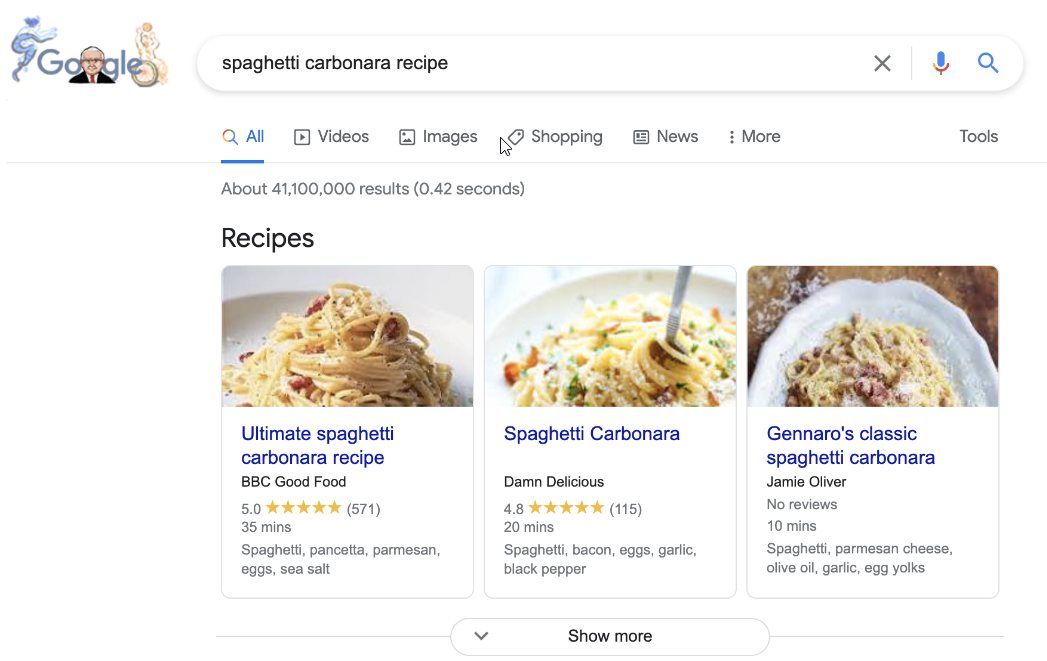
6. Event Schema
- Usage: For describing events such as concerts, webinars, or workshops.
- Attributes: name, startDate, endDate, location, organizer, etc.

7. Person Schema
- Usage: For profiles of individuals, such as authors or speakers.
- Attributes: name, jobTitle, affiliation, email, address, etc.

8. Organization Schema
- Usage: For describing organizations, including companies, non-profits, and institutions.
- Attributes: name, logo, contactPoint, address, sameAs (for social media profiles), etc.
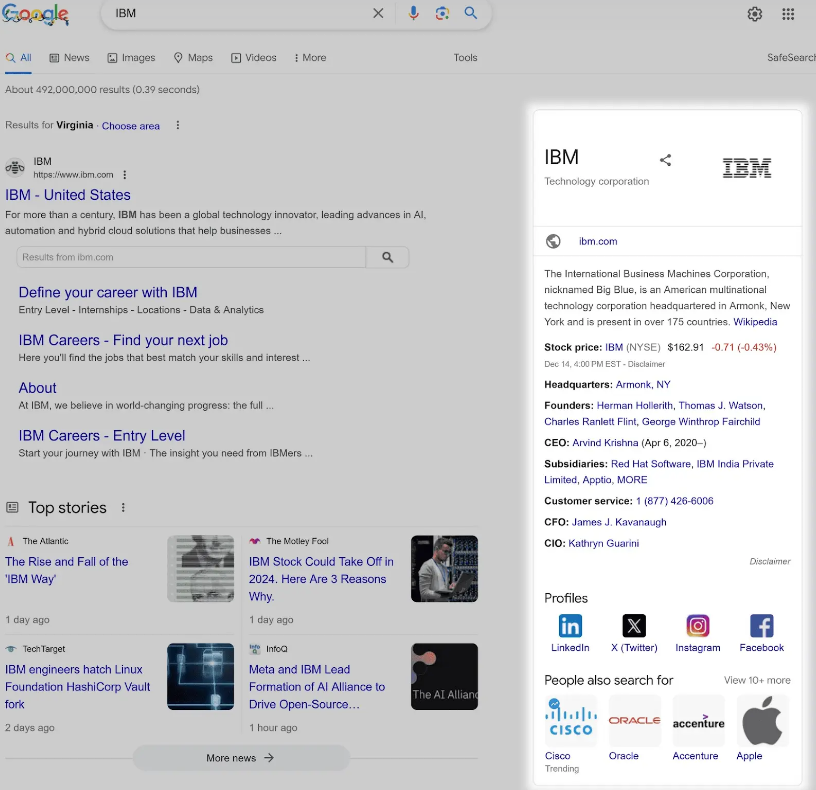
9. Video Schema
- Usage: For embedding videos.
- Attributes: name, description, thumbnailUrl, uploadDate, duration, etc.

10. Job Posting Schema
- Usage: For job listings.
- Attributes: title, description, datePosted, hiringOrganization, jobLocation, employmentType, etc.
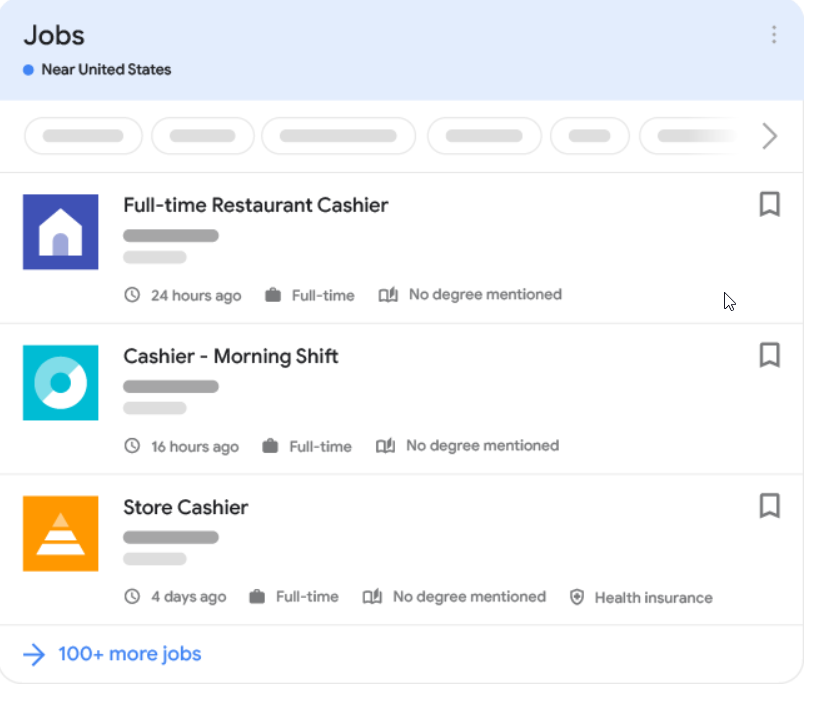
11. Course Schema
- Usage: For educational courses.
- Attributes: name, description, provider, startDate, endDate, etc.

12. Software Application Schema
- Usage: For software apps.
- Attributes: name, operatingSystem, applicationCategory, offers, etc.

13. Voice Search Optimization (On-Page SEO)
How Voice search optimization helps in On-Page SEO
Voice search optimization is the process of enhancing and adjusting our online content to improve its visibility and performance in voice search results. With the increasing use of voice-activated devices like smartphones, smart speakers (e.g., Amazon Echo, Google Home), optimizing for voice search has become an essential part of On-Page SEO (Search Engine Optimization).
The importance of voice search optimization
Optimizing for voice search can help us reach more people than optimizing for text-based searches alone. Research shows that the number of people using digital voice assistants is expected to continue growing.

How to optimize/implement for voice search
- Keyword Research:
- Voice Search-Specific Keywords: Traditional keyword research tools can be adapted to identify long-tail keywords, questions keywords, conversational keywords and phrases that users are likely to speak. Tools like AnswerThePublic, Google’s autocomplete suggestions, and others can provide insights into common questions and phrases used in voice search.
- Natural Language and Question Phrases: Focus on keywords that reflect how people naturally ask questions verbally, such as "how," "what," "where," "when," "why," and "who" queries.
- Content Creation and Optimization:
- Conversational Tone: Develop content that sounds natural when spoken. This involves writing in a more conversational tone and structuring content to answer questions directly.
- FAQs and Featured Snippets: Creating a FAQ section on your site can directly address common voice search queries. Structured answers to questions increase the likelihood of being featured in Google’s answer boxes, which are often used in voice search responses.
- Answering Questions Clearly: Provide clear, concise answers within the first few sentences of your content to capture the attention of voice search algorithms.
- On-Page SEO:
- Structured Data Markup: Implement schema markup to help search engines understand your content's context and improve its chances of appearing in voice search results.
- Page Speed and Mobile Optimization: Ensure that our site loads quickly and is mobile-friendly, as many voice searches are conducted on mobile devices. Tools like Google’s Mobile-Friendly Test and PageSpeed Insights can help identify and fix issues.
- User Experience (UX):
- Content Accessibility: Make sure our content is easily accessible and provides a good user experience. This includes using clear headings, bullet points, and short paragraphs.
- Engaging Content: High-quality, engaging content that retains users on your site can reduce bounce rates and signal to search engines that your site provides valuable information.
- Utilizing Natural Language Processing (NLP):
- Understand and apply NLP principles to create content that aligns with how people naturally speak and ask questions.
Practical Example:
Suppose you run a local bakery. To optimize for voice search, you might:
- Identify common questions like “Where can I find the best cupcakes near me?” or “What are today’s specials at [Your Bakery Name]?”
- Create a FAQ page answering these questions directly.
- Use schema markup to highlight these queries.
- Optimize site for mobile users and ensure fast loading times as most of the voice searches are done on mobile devices/tablets.
Benefits of voice search optimization
1. Enhanced User Experience
- Natural Language Processing: Voice search queries are conversational and often phrased as complete questions. By optimizing for these natural language queries, you create content that is more engaging and user-friendly.
- Quick Answers: By providing clear and concise answers to common questions, you enhance user satisfaction and retention, which can lead to better engagement metrics such as lower bounce rates and longer session durations.
2. Increased Visibility in Search Results
- Featured Snippets: Voice search often pulls answers from featured snippets. Optimizing your content to appear in these snippets can significantly increase your visibility and drive more traffic to your site.
- Position Zero: Achieving a featured snippet, or “position zero,” can dramatically boost your site’s exposure since voice assistants often read out this content directly.
3. Better Mobile Optimization
- Mobile-First Indexing: Since many voice searches are performed on mobile devices, optimizing for voice search also means your site is likely to be better optimized for mobile use, which is a critical ranking factor.
- Site Speed: Voice search users expect quick answers, so optimizing your site’s speed can improve both voice search performance and overall mobile SEO.
4. Higher Engagement and Conversion Rates
- Direct Answers: Providing direct and useful answers to voice queries can increase user engagement and drive higher conversion rates, as users are more likely to find the information they need quickly and act on it.
- Conversational Keywords: Targeting long-tail, conversational keywords can attract more qualified traffic, as these searches often indicate a higher intent to convert.
5. Staying Competitive
- Emerging Trends: As voice search continues to grow in popularity, businesses that optimize for it stay ahead of competitors who do not, ensuring they capture a larger share of this growing segment of search traffic.
- Adaptation to User Behavior: By optimizing for voice search, you adapt to changing user behaviors and preferences, ensuring your SEO strategy remains relevant and effective.
By aligning this SEO strategy with the voice search, we can improve our visibility in voice search results, attract more visitors, and ultimately drive more conversions.
14. Artificial Intelligence (AI) - On-Page SEO
How AI helps in On-Page SEO
1. Automation: Automation in SEO can greatly enhance efficiency, accuracy, and consistency in optimizing websites for search engines. Here are several ways automation helps in SEO
1.1 Content Creation and Optimization
- Content Generation: AI-powered tools such as Jasper (formerly Jarvis) can generate high-quality, SEO-optimized content based on input keywords and guidelines.
- Content Refreshing: Automation tools can identify outdated content and suggest updates to keep it relevant and optimized.
1.2 On-Page SEO
- Meta Tags Optimization: Automation tools can generate and optimize meta titles, descriptions, and header tags based on best practices and target keywords.
- Internal Linking: Tools can automate the process of adding internal links within your site, improving navigation and SEO.
1.3 Performance Tracking
- Rank Tracking: Tools such as SEMrush, Ahrefs, and Google Search Console automatically track keyword rankings over time, providing insights into your SEO performance.
- Traffic Analysis: Google Analytics and other analytics tools can automatically track and report on organic traffic, user behavior, and conversion rates.
1.4 Competitor Analysis
- Benchmarking: Automated tools can continuously monitor competitors' SEO strategies, keyword rankings, and content performance, providing insights into their strengths and weaknesses.
- Gap Analysis: Automation can identify content and keyword gaps where competitors are ranking but your site is not, suggesting opportunities for improvement.
1.5 Reporting and Analytics
- Automated Reports: Tools like Google Data Studio, SEMrush, and Ahrefs can generate detailed SEO performance reports on a regular schedule, saving time and ensuring consistency.
- Custom Dashboards: Automation can create custom dashboards that pull data from various sources, providing a comprehensive view of your SEO efforts in real-time.
Benefits of Automation in On-Page SEO
- Efficiency: Automation saves time by handling repetitive tasks, allowing SEO professionals to focus on strategy and creative aspects.
- Accuracy: Automated tools reduce the risk of human error in data collection and analysis.
- Consistency: Regular automated tasks ensure that SEO efforts are consistent and up-to-date.
- Scalability: Automation allows SEO efforts to scale across large websites and multiple projects without a proportional increase in workload.
- Real-Time Insights: Automated monitoring and reporting provide real-time insights into SEO performance, enabling quicker responses to issues and opportunities.
By leveraging automation in SEO, businesses can improve their search engine visibility more effectively and efficiently, stay ahead of the competition, and ensure websites are optimized continuously.
- AI Personalization - SEO
Implement AI - driven personlization on website to deliver customized content and product recommendations based on user behavior and preferences. This enhances user experience by providing relevant, tailored content that meets individual needs and interests.
How AI-Driven Personalization Works:
- Data Collection:
- Behavioral Data: Track user actions on our website, such as pages visited, time spent on each page, clicks, and purchases. (Google Search Console and Google Analytics)
- Demographic Data: Collect demographic information like age, gender, location, and device used. (Google Search Console and Google Analytics)
- Contextual Data: Consider the context in which users are interacting with our site, such as the time of day or the user's current activity. (Google Search Console and Google Analytics)
- AI Algorithms:
- Machine Learning: Utilize machine learning algorithms to analyze collected data and identify patterns and preferences. (Data Analytics)
- Personalized Content Delivery:
- Content Recommendations: Suggest articles, blog posts, or videos that align with the user’s interests. (Dynamic Suggestions)
- Product Recommendations: Display products similar to those the user has previously viewed or purchased. (Dynamic Suggestions)
- Dynamic Content: Customize website elements like banners, headlines, and calls-to-action based on user segments. (Dynamic Suggestions)
Benefits of AI-Driven Personalization:
- Increased Engagement: Personalized content keeps users engaged, increasing time spent on the site and reducing bounce rates.
- Higher Conversion Rates: Tailored product recommendations and offers can significantly boost conversion rates and sales.
- Improved Customer Satisfaction: Delivering relevant content improves the user experience, leading to higher customer satisfaction and loyalty.
- Better Insights: AI-driven analytics provide deeper insights into user behavior and preferences, helping refine marketing and content strategies.
Example of Implementation:
Suppose we run an online clothing store. Using AI-driven personalization, we can:
- Track User Behavior: Monitor which categories (e.g., men’s clothing, women’s accessories) each visitor is interested in.
- Analyze Data: Use AI to analyze this behavior and predict future preferences, such as styles or brands the user might like.
- Deliver Personalized Experiences: Show personalized product recommendations on the homepage, customize email newsletters with products the user is likely to be interested in, and provide targeted promotions.
Imagine we operate a travel website. By using AI-driven personalization, we can:
- Track Preferences: Identify user preferences such as preferred destinations, travel styles, and budget ranges.
- Recommend Content: Provide personalized travel guides, destination recommendations, and deals based on these preferences.
- Enhance Experience: Tailor the homepage and navigation to highlight content and deals most relevant to each user.
- Analyze Data: Use insights from user interactions to refine your content strategy, focusing on popular destinations or travel tips.
How AI Driven Personalization Implementation helps SEO
Implementing AI-driven personalization can significantly enhance our SEO efforts by improving user experience, engagement, and ultimately, search engine rankings.
1. Improved User Engagement
- Increased Time on Site: Personalized content keeps users engaged, leading to longer session durations. Search engines like Google consider time spent on site as a positive ranking signal, indicating that your content is valuable to users.
- Lower Bounce Rates: When users find relevant content quickly, they are less likely to leave your site immediately. A lower bounce rate can positively impact our SEO, as it suggests that your site provides valuable information.
2. Higher Conversion Rates
- Targeted Recommendations: Personalized product and content recommendations can increase the likelihood of conversions. Higher conversion rates can indirectly improve SEO by increasing user satisfaction and encouraging repeat visits.
- User Satisfaction: Satisfied users are more likely to engage with your content, share it, and link back to it, all of which are beneficial for SEO.
3. Enhanced User Experience (UX)
- Relevance: Providing relevant content tailored to individual user preferences enhances the overall user experience. Search engines prioritize sites that offer a good user experience, which can improve our rankings.
- Navigation: Personalized navigation helps users find what they’re looking for more easily, reducing frustration and improving usability. Good site navigation is a critical factor for SEO.
4. Increased Dwell Time
- Engaging Content: Personalized content that resonates with users can keep them on your site longer. Dwell time, or the time a user spends on your page before returning to the search results, is an important metric for SEO.
- Content Interaction: Personalized experiences encourage users to interact with more content on your site, such as related articles or products, further increasing dwell time.
5. Better Insights for Content Strategy
- User Behavior Analysis: AI-driven personalization provides detailed insights into user behavior and preferences. This data can inform our content strategy, helping us create content that better meets the needs and interests of your audience.
- Content Gaps: By understanding what users are searching for and not finding, we can identify content gaps and create new content to fill these gaps, improving your site’s relevance and comprehensiveness.
AI for SEO can assist marketers to unearth trending keywords and topics. They can gain a better understanding of customers’ buying patterns and behaviors, and target markets in a fraction of the time.
By implementing AI-driven personalization, we can create a more relevant and enjoyable experience for each visitor, ultimately driving better business outcomes. As a result, users spend more time on your site, engage with more content, and are more likely to convert, all of which contribute to better SEO performance.
- Predictive Analysis with AI
This involves using data and AI algorithms to identify the likelihood of future outcomes based on historical data. In the context of SEO, predictive analysis can significantly enhance our strategy by providing insights into future trends and user behaviors, allowing us to stay ahead of the competition and optimize our efforts more effectively.
1. SEO Forecasting
- Anticipate Trends: Predictive analytics tools analyze past and current data to forecast future search trends. This will helps us to identify which topics or keywords will likely gain popularity, allowing you to create content that meets upcoming demand. (Data Analytics)
- Adapt to Search Behavior Changes: By understanding potential shifts in search behavior, we can adjust our SEO strategy proactively. This might involve optimizing existing content, creating new content, or adjusting keyword targeting to align with emerging trends.
- Tools: Platforms like BrightEdge and Conductor offer predictive analytics features. These tools provide data-driven insights to help us forecast SEO performance and identify new opportunities for growth.
2. User Behavior Prediction
- Analyze Patterns: Use AI to analyze patterns in user behavior, such as which types of content or products are frequently interacted with, which pages have high bounce rates, or which keywords drive the most traffic. (Data Analytics, Google Analytics)
- Content and Product Success: Predictive analytics can help determine which content topics or product categories will be most successful based on historical performance and current trends. This allows us to focus our efforts on creating and promoting content that is more likely to perform well. (Data Analytics, Google Analytics)
- Personalization: By predicting user preferences, we can personalize content and recommendations, improving user experience and engagement. This can lead to higher conversion rates and better SEO outcomes.(Data Analytics, Google Analytics)
Benefits of Predictive Analytics in SEO
- Stay Ahead of Trends: By anticipating trends before they become mainstream, we can position our content to capture early search traffic and build authority in emerging topics.
- Efficient Resource Allocation: Focus our SEO resources on areas with the highest potential return, optimizing our content strategy and improving overall efficiency.
- Improved Decision Making: Data-driven insights from predictive analytics support more informed decision-making, reducing guesswork and increasing the effectiveness of your SEO efforts.
- Enhanced User Experience: Understanding and predicting user behavior will allow us to tailor content to meet user needs, improving satisfaction and engagement.
Example:
Suppose we manage a tech blog. Using predictive analytics, we might:
- Trend Forecasting: Analyze search data to predict upcoming trends in technology, such as new developing service or software releases.
- Content Planning: Create and publish articles on these predicted trends before they peak, ensuring your content is available when interest surges.
- Behavior Analysis: Monitor which articles receive the most engagement and predict future interests based on this data.
- Personalized Recommendations: Offer personalized content recommendations to returning users based on their previous interactions and predicted interests.
Imagine you run an e-commerce site specializing in electronics.
- Trend Forecasting:
- Predict an upcoming surge in interest for a new smartphone model.
- Create detailed guides, reviews, and comparison articles before the product release.
- Keyword Optimization:
- Analyze search data to identify growing keyword trends related to the new smartphone.
- Optimize existing content and create new content targeting these keywords.
- Content Refresh:
- Use predictive insights to identify older smartphone reviews that need updating.
- Refresh content to include comparisons with the latest models and current pricing.
- Personalized Recommendations:
- Offer personalized product suggestions based on user browsing history and predicted interests.
- Enhance user experience by displaying relevant accessories and related products.
Tools for Predictive Analytics
- BrightEdge: Provides predictive analytics for content performance, keyword trends, and competitive analysis, helping us stay ahead in SEO.
- Conductor: Offers tools for understanding and predicting changes in search behavior, allowing you to optimize your content strategy effectively.
By leveraging predictive analytics, we can create a proactive, data-driven SEO strategy that enhances our site's visibility, relevance, and user engagement, leading to improved search engine rankings and overall performance.
15. Tools for On-Page SEO
On-Page SEO involves a variety of tools that help improve a website's visibility and ranking on search engine results pages (SERPs). Here is a description of some common types of tools used in On-Page SEO:
1. Keyword Research
- Purpose: Identify relevant keywords and phrases that potential visitors are searching for.
- Examples: Google Keyword Planner, SEMrush, Ahrefs.
- Features: Search volume analysis, keyword difficulty, related keyword suggestions, trends over time.
Tool we use - Google Keyword Planner
Google Keyword Planner: Advantages and Disadvantages
Advantages:
- Provides accurate keyword data directly from Google.
- Free to use with a Google Ads account.
Disadvantages:
- Primarily designed for paid search, not SEO.
- Provides broad search volume ranges, which can lack precision.
- Lacks advanced SEO metrics like keyword difficulty in numbers.
- Offers limited insights into the competitive landscape.
- Can be time-consuming due to manual data handling.
SEMrush: Advantages and Disadvantages
Advantages:
- Comprehensive Keyword Research - Offering data on search volume, keyword difficulty, competitive density, and keyword trends over time.
- Competitor Analysis - Detailed insights into competitors' keywords, backlinks, and traffic sources.
- Site Audit - Performs a thorough site audit to identify technical SEO issues, including broken links, duplicate content, and crawl errors.
- On-Page SEO - Provides on page SEO recommendations, including keyword usage, content suggestions, and technical improvements.
- Content - Includes tools for content analysis, topic research, and content performance tracking.
- Keyword Position Tracking - Tracks the daily rankings of target keywords and provides insights into local and mobile rankings.
Disadvantages:
- Cost - May not be affordable for all, limiting access to its full range of features.
Recommendation:
SEMrush - SEMrush is a powerful SEO tool with a broad range of features that can significantly enhance an SEO strategy. However, potential users should consider the cost, learning curve, and data accuracy when deciding whether it is the right tool for their needs.
2. On-Page SEO Tools
- Purpose: Optimize individual pages to rank higher and earn more relevant traffic.
- Examples: SEMrush On-Page SEO Checker, Moz On-Page Grader, Screaming Frog SEO Spider.
- Features: Meta tag optimization, content analysis, keyword density, readability scores.
Tool we use - NA
SEMrush: Advantages and Disadvantages
Advantages:
- Comprehensive Keyword Research - Offering data on search volume, keyword difficulty, competitive density, and keyword trends over time.
- Competitor Analysis - Detailed insights into competitors' keywords, backlinks, and traffic sources.
- Site Audit - Performs a thorough site audit to identify technical SEO issues, including broken links, duplicate content, and crawl errors.
- On-Page SEO - Provides on page SEO recommendations, including keyword usage, content suggestions, and technical improvements.
- Content - Includes tools for content analysis, topic research, and content performance tracking.
- Keyword Position Tracking - Tracks the daily rankings of target keywords and provides insights into local and mobile rankings.
Disadvantages:
- Cost - May not be affordable for all, limiting access to its full range of features.
Recommendation:
SEMrush - SEMrush is a powerful SEO tool with a broad range of features that can significantly enhance an SEO strategy. However, potential users should consider the cost, learning curve, and data accuracy when deciding whether it is the right tool for their needs.
3. Rank Tracking Tools
- Purpose: Monitor the ranking of a website for specific keywords over time.
- Examples: SEMrush, AccuRanker, SERPWatcher
- Features: Daily rank updates, historical data, mobile vs. desktop rankings, competitor tracking.
Tool we use - Google Search Console
Google Search Console: Advantages and Disadvantages
Advantages:
- Free to use - GSC is completely free, making it an accessible option for businesses of all sizes, from small startups to large enterprises.
- Search Performance Report - The Search Performance report in GSC offers detailed insights into impressions, clicks, average position, and CTR for keywords, pages, and queries.
- Data from Google - Google Search Console (GSC) provides data directly from Google, ensuring accuracy and reliability in tracking keyword rankings and search performance.
Disadvantages:
- Less comprehensive than other paid tools - While GSC provides essential data, it lacks some of the advanced features and detailed insights offered by paid SEO tools like SEMrush, Ahrefs, or Moz.
- Inaccuracy Data - Most of the time keyword position shown in GSC are inaccurate.
- Limited Data - GSC only retains search performance, which can be a limitation for long-term trend analysis.
- Rank Tracking Alerts - Unlike some paid tools, GSC does not provide automatic alerts for significant changes in rankings, requiring users to manually check for updates.
- Data Delay - GSC data is not real-time and can have a delay of a few days, which may affect timely decision-making.
SEMrush: Advantages and Disadvantages
Advantages:
- Accurate Keyword Position Tracking - SEMrush provides accurate and up-to-date tracking of keyword rankings.
- Daily Updates - Users can receive daily updates on keyword rankings, allowing for timely adjustments to SEO strategies based on the latest data.
- Mobile and Desktop Tracking - SEMrush tracks keyword rankings separately for mobile and desktop searches, providing insights into performance across different device types.
- Competitor Tracking - The tool allows users to track competitors’ keyword rankings, offering a competitive edge by understanding their SEO strategies and performance.
- Visibility Score - SEMrush provides a visibility score that indicates the overall visibility of a website based on its ranking positions, offering a quick snapshot of SEO performance.
Disadvantages:
- Cost - May not be affordable for all, limiting access to its full range of features.
Recommendation:
SEMrush - SEMrush offers robust and comprehensive rank tracking features, including accurate daily updates, competitor analysis, and local SEO tracking. However, its cost, complexity, and potential data discrepancies are important considerations for users. Balancing these benefits and disadvantages will help determine if SEMrush is the right tool for rank tracking needs.
4. Content Optimization Tools
- Purpose: Improve the quality and relevance of website content.
- Examples: SEMrush, SurferSEO, MarketMuse.
- Features: Content scoring, keyword recommendations, content gaps, readability enhancements.
Tool we use - NA
SEMrush: Advantages and Disadvantages
Advantages:
- Extensive Keyword Research for Content - SEMrush provides extensive keyword research tools, offering insights into keyword volume, difficulty, trends, and related keywords to optimize content effectively.
- SEO Writing Assistant - This feature helps in real-time to optimize content by providing recommendations on readability, keyword usage, and tone of voice.
- Content Audit - SEMrush’s Content Audit tool evaluates the performance of existing content, identifying pages that need updates, consolidation, or removal based on metrics like traffic, backlinks, and engagement.
- Topic Research - This tool aids in discovering new content ideas by analyzing top-performing content on the web, suggesting popular topics, headlines, and questions to address in your content.
- SEO Content Template - SEMrush generates SEO-friendly content templates based on the top 10 results for your target keywords, providing recommendations on content length, keywords to include, and backlink opportunities.
- Content Performance Tracking - SEMrush helps track the performance of your content over time, providing insights into traffic, engagement, and conversion metrics to refine and improve your content strategy.
Disadvantages:
- Cost - May not be affordable for all, limiting access to its full range of features.
- Free Features - The free version of SEMrush offers limited features, and users need to subscribe to a paid plan to access the full suite of content optimization tools.
Recommendation:
SEMrush - SEMrush offers powerful tools for content optimization, including comprehensive keyword research, real-time SEO assistance, content auditing, and competitor analysis. However, its cost, complexity, and potential data inaccuracies are important considerations. Balancing these benefits and disadvantages will help determine if SEMrush is the right tool for your content optimization needs.
5. Analytics Tools
- Purpose: Track and analyze website performance and user behavior.
- Examples: Google Analytics, Google Search Console
- Features: Traffic analysis, user behavior insights, conversion tracking, custom reporting.
6. Competitor Analysis Tools
- Purpose: Understand and analyze competitors for SEO strategies.
- Examples: SEMrush, Ahrefs, SpyFu
- Features: Competitor keyword analysis, traffic estimates, backlink comparisons, content strategies.
Tool we use - NA
SEMrush: Advantages and Disadvantages
Advantages:
- Competitor Keyword Analysis - SEMrush allows you to identify the keywords that your competitors are ranking for, giving you insights into their SEO strategies and opportunities for your own optimization efforts.
- Content Gap Analysis - SEMrush helps you identify gaps in your content compared to competitors by showing which keywords they rank for but you don’t. This allows you to create content that fills those gaps and attracts more traffic.
- Competitor Traffic Analysis - You can estimate your competitors' website traffic, including their organic and paid search traffic, giving you benchmarks to strive for and insights into their overall online visibility
Disadvantages:
- Cost - May not be affordable for all, limiting access to its full range of features.
- Competitor Coverage - While SEMrush covers a wide range of competitors, it may not have data on all competitors in niche or emerging markets, potentially limiting insights in those areas.
Recommendation:
SEMrush - SEMrush offers powerful tools for competitor analysis in SEO, providing insights into keywords, backlinks, content strategies, and market trends. However, its cost, complexity, and potential data inaccuracies are important considerations. Businesses should weigh these benefits and disadvantages to determine if SEMrush is the right tool for their competitor analysis needs.
16. Latest google updates 2024 - SEO
- Spam Update - June 2024
The June 2024 Spam Update aims to enhance search result quality by targeting various spammy practices. Here are the main key points:
- Focus on Spam Reduction: The update targets websites that violate Google’s spam policies, including automated content generation, link manipulation, low-quality content, and deceptive techniques like hidden redirects Search Engine Land.
- Impact on Rankings: Websites engaging in spammy practices may experience a decline in visibility, while those adhering to Google’s guidelines could see improvements in their search rankings. Fluctuations in search results are expected during the rollout period Search Engine Land Search Engine Journal.
- Not Related to Other Updates: Google has clarified that this spam update is not the algorithmic version of the site reputation abuse policy enforcement and is not related to link spam specifically.
- Site Reputation Abuse - May 2024
The May 2024 update to Google's Site Reputation Abuse policy focuses on addressing manipulative practices involving low-quality third-party content on reputable sites. Here are the key points:
- Definition of Site Reputation Abuse:
- This involves websites with their own quality content hosting low-quality third-party pages to manipulate search rankings. This practice, known as "parasite SEO," leverages the host site's reputation to boost the visibility of poor-quality content.
- Enforcement Phases:
- Algorithmic Detection: An upcoming algorithmic update will automatically identify and penalize sites engaging in reputation abuse Search Engine Devil Search Engine Journal.
- Targeted Content:
- Examples include coupon codes, gambling sites, and spammy product reviews hosted on reputable domains. Sites like CNN, USA Today faced penalties for such practices SEOSLY.
- Quality Oversight:
- Not all third-party content is bad. High-quality, relevant third-party content that is closely overseen by the host site is acceptable. The policy specifically targets low-quality content with little to no oversight that aims to manipulate search rankings SEOSLY.
- Impact on Websites:
- Websites hosting third-party content need to ensure it is relevant, high-quality, and beneficial to users. Failure to comply can result in significant penalties, including loss of search visibility Search Engine Journal.
To prepare, website owners should focus on producing high-quality, relevant content and maintain strict oversight over any third-party content to ensure it aligns with Google's guidelines.
- Core Update - March 2024
The March 2024 Google Core Update brought several significant changes aimed at improving the quality of search results by reducing low-quality and unoriginal content. Here are the key points:
- Focus on Content Quality: The update emphasizes originality, depth, and value for the user. Google aims to reduce low-quality content in search results by 40%, targeting sites that primarily create content for search engines rather than for users Search Engine Journal.
- E-E-A-T (Experience, Expertise, Authoritativeness, Trustworthiness): This update reinforces the importance of E-E-A-T. Websites with outdated, error-filled, or AI-generated content that lack clear oversight are particularly vulnerable. Google prioritizes content that demonstrates real expertise and provides substantial, original information Search Engine Land.
- Addressing Site Reputation Abuse: Google targets manipulative practices where trusted websites host low-quality third-party content to exploit their strong reputations. Examples include hosting irrelevant third-party reviews or coupon pages to manipulate search rankings Search Engine Journal.
- Technical and User Experience Factors: Beyond content, the update stresses the importance of technical SEO and user experience. This includes site structure, internal linking, mobile performance, page speed, and clear calls to action. Websites that focus solely on keyword optimization without considering user experience are likely to be penalized.
- Immediate Penalties and Monitoring: Penalties for violating the new guidelines are prompt and severe. Affected sites may experience significant drops in rankings or complete deindexing from search results. Google does not notify site owners of these changes, so continuous monitoring of traffic and rankings using tools like Google Search Console is essential Search Engine Land.
Overall, the update underscores Google's commitment to improving search result quality by rewarding high-quality, user-centric content and penalizing manipulative practices.
Conclusion
On-page SEO is crucial for improving your website's visibility in search engines, attracting targeted traffic, enhancing user experience, and ultimately achieving your business goals online. It forms the foundation of our SEO strategy and should be continuously optimized to stay competitive in search engine rankings.
On-Page SEO Checklist
Checkpoints to be checked by:
- SEO Team
- Content Team
- Tech Team
- Project Manager
On-Page SEO Checklist:
- Target Keywords: Identify and analyze the search terms people are using to find your business.
- URL Structure Optimization: Ensure URLs are easy to read and in lower case.
Example:- https://www.{domain-name}.com/ - Title Tag: Keep the title tag between 50-60 characters to ensure it displays properly in SERPs.
Title Tag Placement: Within the section of an HTML document.
Example:- <title>Your Page Title</title>
- Description Tag: Aim for a meta description length of around 150-160 characters.
Description Tag Placement: Within the section of an HTML document.
Example:- <meta name="description" content="Your description here">
- Canonical Tag: Use consistently across website to point the preferred version of each page.
Canonical Tag Placement: Within the section of an HTML document.
Example:- <link rel="canonical" href="self_referencing_page_url" />
- Breadcrumb: Site’s hierarchy, starting with homepage, through categories to current page.
Example:- Home / Technologies / Frameworks / Vue JS Development Services - Robots Tag: HTML tag used to control how search engines crawl and index the pages.
Robots Tag Placement: Within the section of an HTML document.
Example:- <meta name="robots" content="index, follow">
- Internal Linking: Improve navigation by linking one page to another page within website.
- Heading Tags: HTML tags used to create headings and subheadings on a web page.
Header Tag Placement: Within the section of an HTML document.
- Header Tag (H1): There should be just 1 H1 tag that reflects the main topic of the page.
Example:- <h1>page heading</h1> - Header Tag (H2): Keep subheadings (Relevant to H1 heading) as H2 tag.
- Content Optimization: Ensure Content is High quality, relevant and provides value to users.
- Add Target Keywords in Body Content
- Review Content Quality
- Add Engaging Visual Content (Images and Videos where needed)
- Voice Search Optimization
- Incorporate question words like who, what, where, why, and how in body content and FAQs.
Example:- “How to optimize for voice search” instead of “voice search optimization”
- Incorporate question words like who, what, where, why, and how in body content and FAQs.
- Image Optimization: It involves enhancing the quality and relevance of images
- Image Alt Tags: Use descriptive, keyword-rich alt text for all images used.
Example:- img src="blue-running-shoes.jpg" alt="Blue running shoes for men" - Image File Name: Use descriptive file names with keywords as file name.
Example:- "blue-running-shoes.jpg" instead of "IMG_1234.jpg".
- Image Alt Tags: Use descriptive, keyword-rich alt text for all images used.
- Rich Snippets: Apply Schema Markups - It helps search engines to understand the content better.
Rich Snippets Placement: Within the section of an HTML document.
- Organization Schema: For describing organizations, business.
- Breadcrumb Schema: For making navigation easier and more intuitive.
- FAQ Schema: It helps search engines understand the content on a web page.
- Review & Rating Schema: It shows user reviews and ratings of products, services, or businesses.